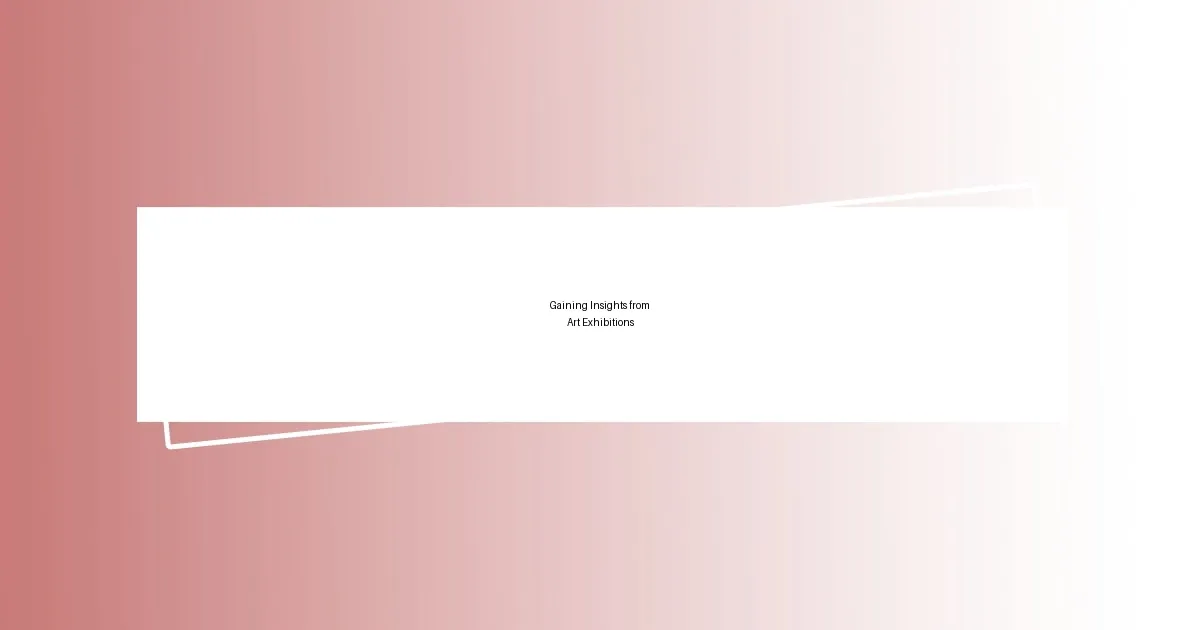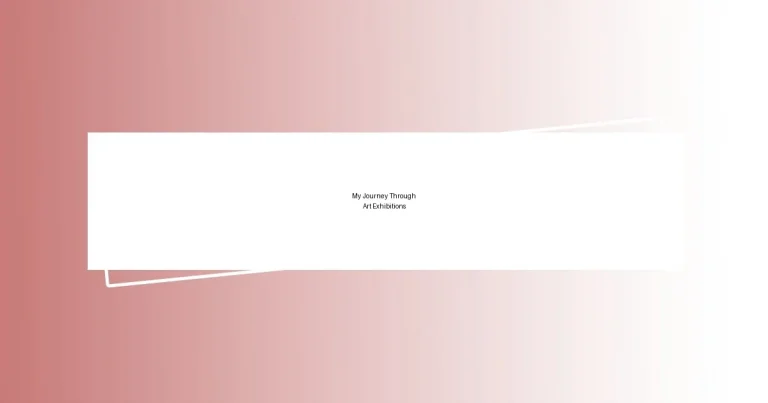Key takeaways:
- Art exhibitions create unique emotional connections through individual interpretations of artworks.
- Preparation for an exhibition involves practical steps and emotional readiness, including layout design and rehearsing presentations.
- Networking at exhibitions can lead to unexpected opportunities and collaborations.
- Reflecting on exhibition experiences enhances personal understanding of art and fosters creative expression.

Understanding Art Exhibitions
Art exhibitions serve as a window into the creative minds of artists, showcasing their work in a curated space where every piece tells a story. I still vividly recall my first experience at a contemporary art exhibition; the atmosphere buzzed with excitement and curiosity, leaving me eager to delve into each artwork’s significance. How can a blank canvas evoke such powerful emotions? That’s the magic of art—each viewer interprets the work through their own lens, creating unique connections.
As I wandered through different galleries, I noticed that exhibitions often reflect broader societal themes or historical contexts. For instance, I attended an exhibition focused on environmental issues that left a profound impact on me. It wasn’t just about viewing the art; it was about understanding the messages behind them. Isn’t it fascinating how a simple brushstroke can spark discussions about climate change or cultural identity?
Exhibitions also encourage conversations among visitors, making them dynamic spaces of interaction. I remember striking up a dialogue with a fellow attendee about a thought-provoking installation, and through our discussion, I gained fresh perspectives on the artwork. Can you imagine how many stories and insights are exchanged in these spaces? Each exhibition, in its own way, invites us to engage, reflect, and share, making the experience truly unforgettable.

Preparing for Art Exhibitions
Preparing for an art exhibition is both thrilling and a bit daunting. I remember days leading up to my first solo show, meticulously arranging each piece. The energy of anticipation surged within me; it was like preparing for a big performance. I wrote down everything I’d need: labeling works, setting the lighting, and even planning my attire. What I discovered was that preparation isn’t just practical—it’s emotional.
One vital step I learned through experience is creating an engaging layout. I often sketch out the exhibition space, imagining how each artwork interacts with others. During my last exhibition, I arranged the pieces to tell a story, allowing viewers to journey from one concept to another fluidly. When the opening night arrived, I watched as patrons moved through the space, their connections deepening as they absorbed the narrative. It’s remarkable how art can lead us through various emotional landscapes if thoughtfully laid out.
I also found that practice makes a significant difference. Whether it’s rehearsing my speech or discussing the pieces with friends beforehand, I realize that being prepared allows me to connect more authentically with visitors. There’s something fulfilling about sharing one’s passion and knowledge. Have you ever felt that rush when explaining something you truly love? When I finally stepped into the exhibition, I felt a wave of confidence, knowing I was ready to share my journey through art.
| Preparation Step | Personal Experience |
|---|---|
| Creating a Checklist | Before my first exhibition, I wrote down every detail, from artwork labeling to opening night snacks. |
| Layout Design | Sketching the exhibition space helped me visualize the audience’s experience—essential for storytelling through art. |
| Rehearsing | Practicing my speech with friends boosted my confidence and allowed me to connect better with visitors. |

Developing an Art Exhibition Plan
Developing an art exhibition plan is an intricate blend of creativity and organization. I distinctly remember the excitement mingled with apprehension as I outlined my first exhibition. Each element, from theme selection to logistical details, felt like a delicate puzzle. Honestly, it was both exhilarating and overwhelming to see everything come together. My advice? Approach it step by step.
Here are some key components to consider when crafting your plan:
- Define the Theme: Choose a central idea that binds the artworks together, drawing viewers into a cohesive story.
- Select the Venue: The space should complement the theme. Each venue has its own atmosphere that can enhance or contrast the pieces.
- Budgeting: Keep track of expenses, including materials, marketing, and refreshments. I learned the hard way that costs can quickly spiral if you’re not attentive.
- Promotional Strategy: Think about how you’ll attract visitors. Social media is a gem; I found that posting sneak peeks created buzz and anticipation.
- Installation Timeline: Allocate time for setup, ensuring all pieces are properly displayed. I remember my last exhibition feeling rushed, and it taught me the value of preparation.
By focusing on these areas, you’ll create a comprehensive plan that not only showcases art but also resonates with visitors on a personal level.

Networking at Art Exhibitions
Networking at art exhibitions can be one of the most rewarding experiences. I recall standing in a gallery, feeling both excited and slightly anxious as I was surrounded by artists and art enthusiasts. Striking up conversations was challenging initially, but I quickly learned that genuine curiosity about others’ work opens doors. Have you ever noticed how a simple compliment can spark a meaningful dialogue?
Through my journey, I’ve realized that every conversation can lead to unexpected opportunities. At one exhibition, I met a gallery owner who shared my passion for contemporary art. Our discussion about our favorite pieces turned into a collaboration that I didn’t foresee. It’s fascinating how a shared appreciation for art can foster connections that might transform your career.
I also discovered the significance of follow-up. After meeting fascinating people, I found sending a quick email or connecting on social media kept the conversation alive. Each connection often leads to new opportunities—whether it’s an invitation to another event or insights about upcoming exhibitions. Whenever someone reached out to me, it felt like a reaffirmation of our initial spark. How about incorporating this principle into your networking strategy?

Gaining Insights from Art Exhibitions
Gaining insights from art exhibitions offers a unique window into various artistic expressions. I vividly recall one exhibition where the artist’s process was laid bare through video installations. Watching this creative journey unfold was enlightening; it deepened my appreciation for the final pieces on display. Have you ever felt like understanding the artist’s intent transforms your perception of the artwork?
The discussions sparked by these exhibitions can be incredibly thought-provoking. I remember engaging with a fellow attendee who passionately analyzed a painting. Our conversation peeled back layers of meaning I hadn’t considered; it was a reminder that art is subjective and personal. Each interpretation can shine a new light, making me think, “What other perspectives am I missing?”
I’ve also realized that behind every artwork lies a story waiting to be discovered. During a recent visit, an artist shared the struggles and inspirations behind their work, and it made the pieces all the more poignant. It’s not just about what you see; it’s about what you feel and learn in the process. Isn’t it incredible how art can bridge the gap between different life experiences and foster deeper understanding?

Documenting Your Art Exhibition Experience
Documenting my art exhibition experiences has become not just a habit, but a vital part of how I interact with art. After attending an exhibition, I often jot down my thoughts and impressions in a journal. This simple practice transforms fleeting emotions and insights into lasting memories, enriching my understanding of the art itself. Have you ever tried capturing those initial feelings right after experiencing something powerful?
I remember one particular exhibition where the energy of the crowd added another layer to the artwork. Noticing how people reacted differently to the same piece left me curious about the power of emotion in art. So, I started taking notes on others’ reactions, sketching their expressions—what a revelation! It wasn’t just my perspective that mattered; understanding diverse viewpoints broadened my appreciation. How might your experience change if you focus on the collective dialogue around art?
Photography has also played a key role in my documentation process. I’ve found that snapping pictures of my favorite installations often reignites the emotional impact I felt in the moment. However, I try to capture more than just visuals; I aim to record the atmosphere and stories behind the pieces. In one exhibition, a candid shot of an artist discussing their work poignantly encapsulated their passion. Isn’t it amazing how a single image can be a gateway to so many memories?

Reflecting on Art Exhibition Visits
Reflecting on my visits to art exhibitions often leads me to profound realizations about my own tastes and preferences. For instance, at one exhibition, I was drawn to a series of abstract pieces that seemed chaotic yet inviting. It struck me—was I actually appreciating the tensions within the chaos? This reflection opened my eyes to my preference for art that challenges norms, prompting me to explore what that says about me.
In another instance, I wandered into an installation that encapsulated the passage of time through carefully arranged objects. As I stood there, I felt a deep connection to my own past, recalling moments that shaped my identity. It made me wonder: isn’t art a powerful vessel for nostalgia? Each visit seems to hold a mirror to my soul, revealing hidden layers of emotion I hadn’t recognized before.
I also find that reflecting on these experiences helps me articulate my feelings about art in a more nuanced way. After one exhibition, I spent weeks mulling over a single painting that evoked a sense of loss. It inspired me to write poetry, blending my artistic expressions with those of the featured artist. What a cathartic experience that was! How often do we tap into our creativity as a response to something that truly resonates with us? Each encounter enriches my understanding and adds depth to my artistic journey.














